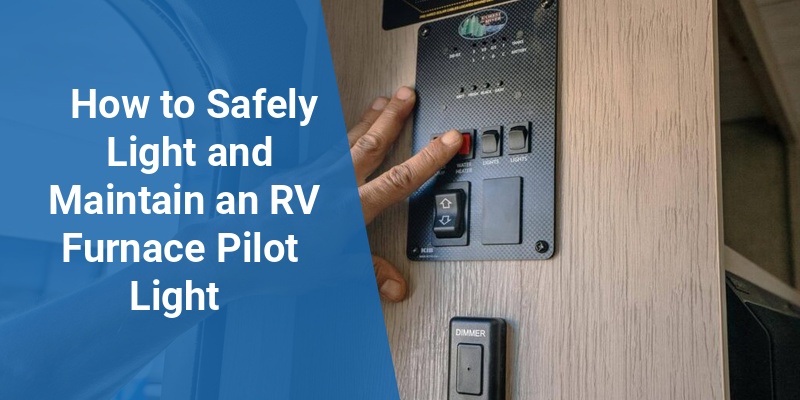Reliable heating in an RV is essential for comfort during cold weather, and the furnace pilot light plays a crucial role in ensuring the furnace operates efficiently. Knowing how to light, troubleshoot, and maintain the RV furnace pilot light can prevent heating failures and improve safety. This article provides detailed guidance on handling pilot lights, common issues, and maintenance tips for RV owners.
| Topic | Key Information |
|---|---|
| Purpose of Pilot Light | Ignites the furnace burner to generate heat safely |
| Common Causes of Pilot Light Outage | Thermocouple issues, gas supply problems, or drafts |
| Steps to Light Pilot Light | Access pilot, turn gas on, ignite, and confirm steady flame |
| Maintenance Tips | Clean burner, check thermocouple, ensure proper ventilation |
| Safety Precautions | Check for gas leaks, ventilate area, follow manufacturer instructions |
What Is an RV Furnace Pilot Light and Why It Matters
The pilot light in an RV furnace is a small flame that ignites the main burner when the furnace is turned on. It provides a continuous ignition source without requiring an electric spark. This pilot flame is critical for safe furnace operation because it ensures that gas only flows when properly ignited, preventing dangerous gas buildup inside the RV. A steady pilot light enables the furnace to heat the RV effectively during cold trips or camping in winter.
Common Reasons the RV Furnace Pilot Light Goes Out
Understanding why the pilot light extinguishes is key to quick troubleshooting. The most frequent causes include:
- Thermocouple Failure: The thermocouple senses the pilot flame’s heat and signals the gas valve to stay open. If faulty or dirty, it can shut off gas supply.
- Gas Supply Issues: An empty propane tank, closed valve, or disrupted fuel line can cause the flame to go out.
- Drafts and Wind: Air movement inside the RV or near the furnace can blow out the pilot flame.
- Dirt and Debris: A dirty pilot assembly can block gas flow or prevent ignition.
- Faulty Gas Valve or Controls: Malfunctions in the furnace’s control systems can interrupt gas delivery to the pilot.
Step-By-Step Guide to Lighting the RV Furnace Pilot Light
Before starting, ensure the RV is parked in a well-ventilated area with no strong drafts. Follow these steps carefully:
1. Turn Off the Furnace and Gas Supply
Set the furnace control to “Off” and close the propane tank valve for safety.
2. Locate the Pilot Light Assembly
Access the furnace compartment, usually at the base or side of the furnace unit. Refer to the RV manual to find the pilot light assembly, which includes the pilot burner and thermocouple.
3. Clear Any Debris
Use compressed air or a brush to clear dirt or cobwebs around the pilot area to ensure proper ignition.
Call 888-906-9139 for Free Local HVAC Quotes – No Obligation, Just Savings!
4. Turn on the Gas Valve to Pilot Position
Slowly open the propane valve and turn the furnace control knob to the pilot setting.
5. Ignite the Pilot Light
Hold a long lighter or match near the pilot opening while pressing the control knob to release gas. Once the flame ignites, hold the knob for 30 seconds to heat the thermocouple.
6. Confirm the Pilot Light Stays Lit
Release the knob and watch the pilot flame. It should be blue and steady. If it goes out, repeat the process or inspect for issues.
How to Maintain Your RV Furnace Pilot Light for Consistent Operation
Regular maintenance can extend the life of the pilot light and keep your furnace running smoothly:
- Clean the Pilot Assembly: Remove dust and debris seasonally to prevent blockages.
- Inspect and Replace the Thermocouple: Test for proper voltage output and replace if readings are weak.
- Check Gas Connections: Routinely inspect hoses and fittings for leaks or damage using a soapy water test.
- Ensure Proper Ventilation: Keep the furnace area free from obstructions and drafts to maintain flame stability.
- Schedule Professional Inspections: Annual checks can catch hidden issues and ensure compliance with safety standards.
Troubleshooting Tips for Pilot Light Problems in RV Furnaces
If the pilot light refuses to stay lit or won’t ignite, consider these common troubleshooting steps:
- Check the Thermocouple: Clean or replace if it’s cold or damaged, as it stops gas flow when malfunctioning.
- Verify Gas Supply: Ensure propane tank is not empty, valves are open, and regulators function properly.
- Inspect for Drafts: Seal any nearby vents or windows that may cause gusts around the pilot flame.
- Examine Igniter or Spark Module: For furnaces with electronic ignition, ensure batteries and wiring are intact.
- Consult the RV Furnace Manual: Follow manufacturer-specific troubleshooting instructions for model variations.
Important Safety Tips When Handling an RV Furnace Pilot Light
Managing gas appliances demands attention to safety. Adhere to these precautions:
- Work in a Well-Ventilated Area: Prevent gas accumulation inside the RV during pilot light operations.
- Use Proper Tools: Utilize long-handled lighters or flame sources to keep hands clear of the pilot assembly.
- Check for Gas Leaks: Always perform a leak test after maintenance using approved leak detection fluids.
- Do Not Force Controls: If valves are hard to turn or pilot won’t light after multiple attempts, consult a professional technician.
- Keep Fire Extinguishers Handy: Equip the RV with a fire extinguisher appropriate for gas or electrical fires.
